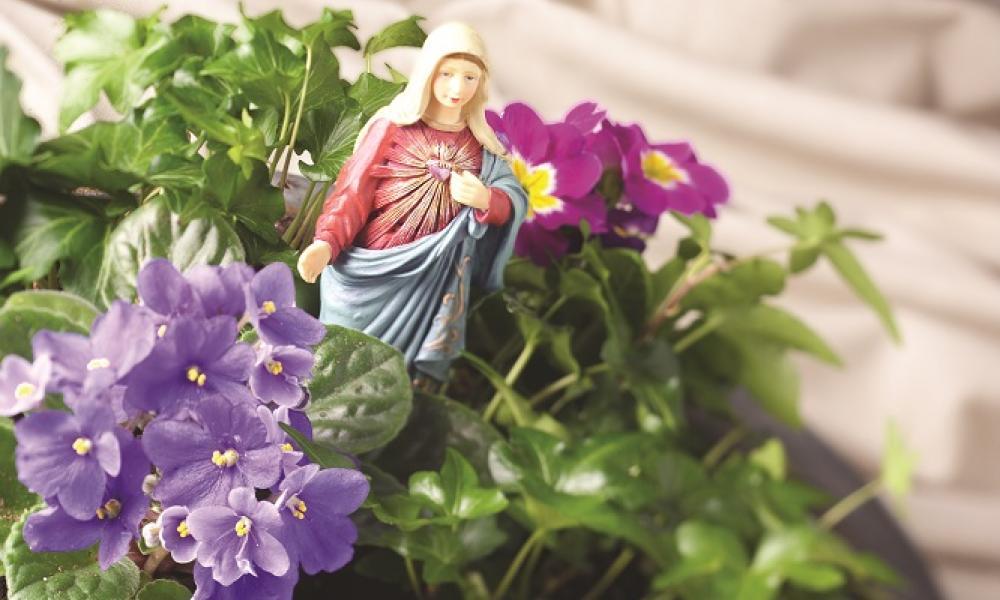
Flowers of Faith
Make your own Mary garden come alive, indoors or out
Make your own Mary garden come alive, indoors or out
Have you ever seen a statue of Mary standing in a flower bed in somebody’s yard? Though these ‘Mary gardens’ may look modern, they actually have an ancient history, dating back to 7th-century Europe, when a saint named Fiacre dedicated his flower garden to Our Lady.
During the Middle Ages, there were so many flowers named for Mary that one could create a garden focused on specific aspects of her life. For example, Our Lady’s Tears (spiderwort) and Mary’s Sword of Sorrow (German iris) might be used to illustrate her suffering, while Virgin Bower (wisteria) and Our Lady’s Modesty (violet) could celebrate her purity. There were even flowers named for parts of her body such as Mary’s Foot (sweet pea) and Eyes of Mary (forget me-not) and others that described her clothing, including Lady’s Veil (baby’s breath) and Our Lady’s Shoes (columbine). Ever wonder about the origin of the word “marigold?” It’s a contraction of the flower name “Mary’s Gold.”
When the Reformation spread through the continent, Marian flowers were renamed in a secular fashion. But, with the help of horticultural historians and folklore experts, hundreds of the original names were rediscovered in the 20th century and serve as the inspiration for Mary gardens, both public and private, all around the world.
The first public Mary garden in the United States was planted in 1932 at St. Joseph’s Church in Woods Hole, Mass. Its 50 flowers dedicated to Our Lady have survived several hurricanes and are beautifully maintained today.
Probably the largest Mary garden in the country – installed in 2000 and occupying three quarters of an acre – exists at the Basilica of the U.S. National Shrine of the Immaculate Conception in Washington, D.C. And another major installation may be found just east of there, at St. Mary’s Parish in Annapolis, Md.
In Michigan, the Mary garden at the parish of St. Catherine of Siena, Portage, is very well regarded. Flanking the south side of the church, this garden features a specially commissioned statue of Mary, Model of the Church.
Mary gardens make a wonderful parish, school or cemetery project. And you can easily adapt this idea for your home as well. Are you really limited in the space you can devote to gardening? A dish or patio pot can serve the same purpose. A Web site called Mary’s Gardens (www.mgardens.org) is the source for the following small-space garden ideas.
Indoor Dish Version
Select a dish or other container at least 3 inches deep. Decide whether you will place your garden in a north, south, east or west window. Then, select 4-6 light-appropriate plants from the following list (common names used here): olive tree, shamrock, star of Bethlehem, iris, crown of thorns, Kenilworth ivy, Spanish moss, rue, begonia, lady’s mantle, heart vine, or prayer plant.
Place a 1/4-inch layer of charcoal chips or pellets at the bottom of the container for drainage. Then fill with a moist, professional potting soil to 5/6 of the height of the container. Position a small statue of Our Lady and your plants in the dish in an artistic fashion, allowing for a soil space around each plant of 1 1/2 times the diameter of the root mass. Firm the soil, water and move to the planned location.
Add water by filling the space fully from the top of the soil to the rim of the container whenever the soil is found to be dry. Nutrients to encourage plant growth can be provided in a water-soluble fertilizer applied every few weeks.
When plant growth slows or stops, reduce temperature, light, moisture and nutrients for 8-10 weeks. Then resume normal care for a new cycle of growth. Prune roots and shoots at the start of a new growth period to maintain desired size.
Patio Pot Version
Select a 10” to 15”-wide pot and 4-6 plants from the following list (again, common names are used): garden balsam, love-in-a-mist, pansy, sweet scabious, English daisy, annual larkspur, marigold, morning glory, forget-me-not, patient Lucy, bachelor’s button, petunia, or zinnia. Choose a location for your patio pot that has at least 5 hours a day of full sun.
Then, follow the planting, watering, and fertilizing guidelines described above.
More about Mary gardens
The Web site mentioned in this article – www.mgardens.org – is a wonderful resource for Mary garden information, with pages devoted to everything from computer-aided garden design to mail-order sources for seeds and plants. Additionally, Vincenzina Krymow has authored a book that combines text describing the legends that inspired the names of many Marian flowers with illustrations drawn from medieval woodcuts. Titled Mary’s Flowers: Gardens, Legends and Meditations, this book is available from St. Anthony Messenger Press and can be ordered online at www.americancatholic.org.



